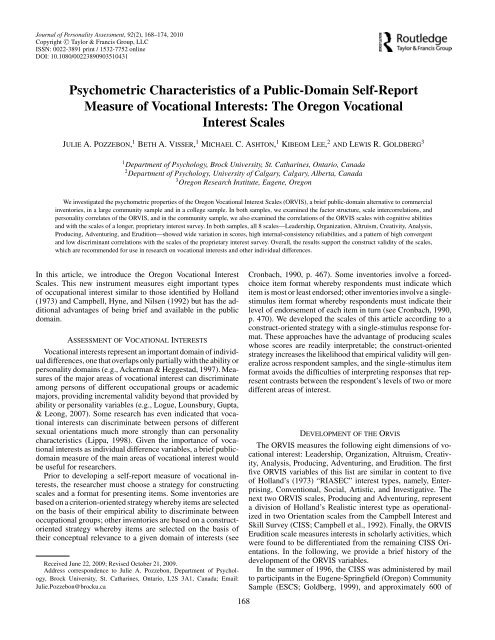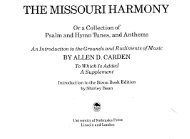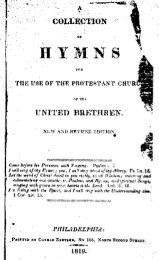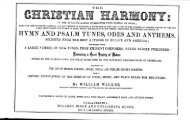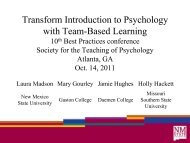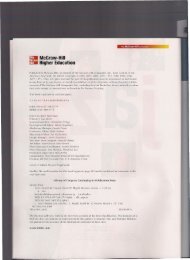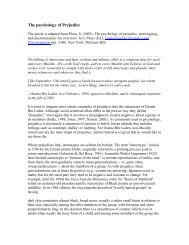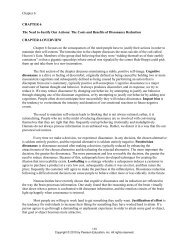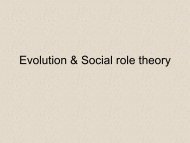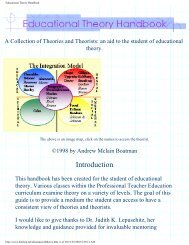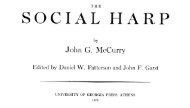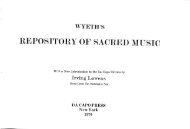Pozzebon et al.,2010
Pozzebon et al.,2010
Pozzebon et al.,2010
You also want an ePaper? Increase the reach of your titles
YUMPU automatically turns print PDFs into web optimized ePapers that Google loves.
Journ<strong>al</strong> of Person<strong>al</strong>ity Assessment, 92(2), 168–174, <strong>2010</strong><br />
Copyright C○ Taylor & Francis Group, LLC<br />
ISSN: 0022-3891 print / 1532-7752 online<br />
DOI: 10.1080/00223890903510431<br />
Psychom<strong>et</strong>ric Characteristics of a Public-Domain Self-Report<br />
Measure of Vocation<strong>al</strong> Interests: The Oregon Vocation<strong>al</strong><br />
Interest Sc<strong>al</strong>es<br />
JULIE A. POZZEBON, 1 BETH A. VISSER, 1 MICHAEL C. ASHTON, 1 KIBEOM LEE, 2 AND LEWIS R. GOLDBERG 3<br />
1 Department of Psychology, Brock University, St. Catharines, Ontario, Canada<br />
2 Department of Psychology, University of C<strong>al</strong>gary, C<strong>al</strong>gary, Alberta, Canada<br />
3 Oregon Research Institute, Eugene, Oregon<br />
We investigated the psychom<strong>et</strong>ric properties of the Oregon Vocation<strong>al</strong> Interest Sc<strong>al</strong>es (ORVIS), a brief public-domain <strong>al</strong>ternative to commerci<strong>al</strong><br />
inventories, in a large community sample and in a college sample. In both samples, we examined the factor structure, sc<strong>al</strong>e intercorrelations, and<br />
person<strong>al</strong>ity correlates of the ORVIS, and in the community sample, we <strong>al</strong>so examined the correlations of the ORVIS sc<strong>al</strong>es with cognitive abilities<br />
and with the sc<strong>al</strong>es of a longer, propri<strong>et</strong>ary interest survey. In both samples, <strong>al</strong>l 8 sc<strong>al</strong>es—Leadership, Organization, Altruism, Creativity, An<strong>al</strong>ysis,<br />
Producing, Adventuring, and Erudition—showed wide variation in scores, high intern<strong>al</strong>-consistency reliabilities, and a pattern of high convergent<br />
and low discriminant correlations with the sc<strong>al</strong>es of the propri<strong>et</strong>ary interest survey. Over<strong>al</strong>l, the results support the construct v<strong>al</strong>idity of the sc<strong>al</strong>es,<br />
which are recommended for use in research on vocation<strong>al</strong> interests and other individu<strong>al</strong> differences.<br />
In this article, we introduce the Oregon Vocation<strong>al</strong> Interest<br />
Sc<strong>al</strong>es. This new instrument measures eight important types<br />
of occupation<strong>al</strong> interest similar to those identified by Holland<br />
(1973) and Campbell, Hyne, and Nilsen (1992) but has the addition<strong>al</strong><br />
advantages of being brief and available in the public<br />
domain.<br />
ASSESSMENT OF VOCATIONAL INTERESTS<br />
Vocation<strong>al</strong> interests represent an important domain of individu<strong>al</strong><br />
differences, one that overlaps only parti<strong>al</strong>ly with the ability or<br />
person<strong>al</strong>ity domains (e.g., Ackerman & Heggestad, 1997). Measures<br />
of the major areas of vocation<strong>al</strong> interest can discriminate<br />
among persons of different occupation<strong>al</strong> groups or academic<br />
majors, providing increment<strong>al</strong> v<strong>al</strong>idity beyond that provided by<br />
ability or person<strong>al</strong>ity variables (e.g., Logue, Lounsbury, Gupta,<br />
& Leong, 2007). Some research has even indicated that vocation<strong>al</strong><br />
interests can discriminate b<strong>et</strong>ween persons of different<br />
sexu<strong>al</strong> orientations much more strongly than can person<strong>al</strong>ity<br />
characteristics (Lippa, 1998). Given the importance of vocation<strong>al</strong><br />
interests as individu<strong>al</strong> difference variables, a brief publicdomain<br />
measure of the main areas of vocation<strong>al</strong> interest would<br />
be useful for researchers.<br />
Prior to developing a self-report measure of vocation<strong>al</strong> interests,<br />
the researcher must choose a strategy for constructing<br />
sc<strong>al</strong>es and a format for presenting items. Some inventories are<br />
based on a criterion-oriented strategy whereby items are selected<br />
on the basis of their empiric<strong>al</strong> ability to discriminate b<strong>et</strong>ween<br />
occupation<strong>al</strong> groups; other inventories are based on a constructoriented<br />
strategy whereby items are selected on the basis of<br />
their conceptu<strong>al</strong> relevance to a given domain of interests (see<br />
Received June 22, 2009; Revised October 21, 2009.<br />
Address correspondence to Julie A. <strong>Pozzebon</strong>, Department of Psychology,<br />
Brock University, St. Catharines, Ontario, L2S 3A1, Canada; Email:<br />
Julie.<strong>Pozzebon</strong>@brocku.ca<br />
168<br />
Cronbach, 1990, p. 467). Some inventories involve a forcedchoice<br />
item format whereby respondents must indicate which<br />
item is most or least endorsed; other inventories involve a singlestimulus<br />
item format whereby respondents must indicate their<br />
level of endorsement of each item in turn (see Cronbach, 1990,<br />
p. 470). We developed the sc<strong>al</strong>es of this article according to a<br />
construct-oriented strategy with a single-stimulus response format.<br />
These approaches have the advantage of producing sc<strong>al</strong>es<br />
whose scores are readily interpr<strong>et</strong>able; the construct-oriented<br />
strategy increases the likelihood that empiric<strong>al</strong> v<strong>al</strong>idity will gener<strong>al</strong>ize<br />
across respondent samples, and the single-stimulus item<br />
format avoids the difficulties of interpr<strong>et</strong>ing responses that represent<br />
contrasts b<strong>et</strong>ween the respondent’s levels of two or more<br />
different areas of interest.<br />
DEVELOPMENT OF THE ORVIS<br />
The ORVIS measures the following eight dimensions of vocation<strong>al</strong><br />
interest: Leadership, Organization, Altruism, Creativity,<br />
An<strong>al</strong>ysis, Producing, Adventuring, and Erudition. The first<br />
five ORVIS variables of this list are similar in content to five<br />
of Holland’s (1973) “RIASEC” interest types, namely, Enterprising,<br />
Convention<strong>al</strong>, Soci<strong>al</strong>, Artistic, and Investigative. The<br />
next two ORVIS sc<strong>al</strong>es, Producing and Adventuring, represent<br />
a division of Holland’s Re<strong>al</strong>istic interest type as operation<strong>al</strong>ized<br />
in two Orientation sc<strong>al</strong>es from the Campbell Interest and<br />
Skill Survey (CISS; Campbell <strong>et</strong> <strong>al</strong>., 1992). Fin<strong>al</strong>ly, the ORVIS<br />
Erudition sc<strong>al</strong>e measures interests in scholarly activities, which<br />
were found to be differentiated from the remaining CISS Orientations.<br />
In the following, we provide a brief history of the<br />
development of the ORVIS variables.<br />
In the summer of 1996, the CISS was administered by mail<br />
to participants in the Eugene-Springfield (Oregon) Community<br />
Sample (ESCS; Goldberg, 1999), and approximately 600 of
OREGON VOCATIONAL INTEREST SCALES 169<br />
them compl<strong>et</strong>ed the survey. 1 Over the years, Goldberg has carried<br />
out a number of an<strong>al</strong>yses of CISS sc<strong>al</strong>es, the most important<br />
of which for our purposes were an<strong>al</strong>yses of the seven CISS Orientation<br />
sc<strong>al</strong>es. To develop public-domain measures of each of<br />
the CISS Orientations, 2,035 items from the Internation<strong>al</strong> Person<strong>al</strong>ity<br />
Item Pool (IPIP; Goldberg, 1999) were correlated with<br />
the seven sc<strong>al</strong>e scores, and IPIP items were classified by the<br />
CISS sc<strong>al</strong>e with which they were most highly associated. IPIP<br />
items f<strong>al</strong>ling within each category were then selected ration<strong>al</strong>ly<br />
based on the extent of their correlations with the CISS sc<strong>al</strong>e, the<br />
apparent relevance of their content to the construct, and their<br />
lack of redundancy with other items <strong>al</strong>ready selected for that<br />
IPIP sc<strong>al</strong>e. Fin<strong>al</strong>ly, the reliability of preliminary versions of the<br />
new sc<strong>al</strong>es were an<strong>al</strong>yzed, and any items that served to attenuate<br />
sc<strong>al</strong>e reliability were omitted and in some cases replaced with<br />
other IPIP items that functioned more adequately.<br />
All IPIP items are short phrases, beginning with a verb (e.g.,<br />
“Take risks,” “T<strong>al</strong>k softly”). Those IPIP items that turned out<br />
to be most highly associated with the CISS sc<strong>al</strong>es typic<strong>al</strong>ly<br />
included verb<strong>al</strong> phrases involving interest or preference (e.g.,<br />
“Like,” “Do not like,” “Enjoy,” “Do not enjoy,” “Prefer,” “Am<br />
[not] interested in”). To discover wh<strong>et</strong>her the self-reported relative<br />
frequencies of individu<strong>al</strong>s’ actu<strong>al</strong> behavior<strong>al</strong> acts might<br />
turn out to be even b<strong>et</strong>ter measures of interests, Goldberg used<br />
the 400 items in the Behavior<strong>al</strong> Report Inventory (BRI), which<br />
had been administered to the ESCS in 1997, to develop BRI<br />
sc<strong>al</strong>es associated with the seven CISS Orientation sc<strong>al</strong>es using<br />
the exact same procedures used to develop the IPIP sc<strong>al</strong>es. Both<br />
the IPIP and BRI sc<strong>al</strong>es were developed in par<strong>al</strong>lel in 2004<br />
and compared as predictors of the CISS constructs. Information<br />
about both s<strong>et</strong>s of sc<strong>al</strong>es is available from L. R. Goldberg.<br />
In factor an<strong>al</strong>yses of the origin<strong>al</strong> CISS Orientation sc<strong>al</strong>es, separately<br />
for skills and interests, as well as for the new IPIP and<br />
BRI versions of those seven constructs, it was <strong>al</strong>ways necessary<br />
to extract eight factors for the seven sc<strong>al</strong>es to each load<br />
most highly on a separate factor. If less than eight factors<br />
were extracted, the sc<strong>al</strong>es measuring the Producing and An<strong>al</strong>yzing<br />
Orientations <strong>al</strong>ways loaded most highly on the same<br />
factor. In the eight-factor an<strong>al</strong>yses of the origin<strong>al</strong> CISS sc<strong>al</strong>es,<br />
the addition<strong>al</strong> factor included CISS sc<strong>al</strong>es measuring interests<br />
and skills related to such occupations as Translator/Interpr<strong>et</strong>er,<br />
Writer/Editor, Librarian, Liber<strong>al</strong> Arts Professor, and Musician<br />
and to such basic interests as Writing and Internation<strong>al</strong> Activities.<br />
Seemingly, then, the addition of an eighth dimension (which<br />
Goldberg c<strong>al</strong>led “Erudition”) to the Holland (1973) six and the<br />
Campbell <strong>et</strong> <strong>al</strong>. (1992) seven might be warranted. Although such<br />
an addition<strong>al</strong> dimension is unlikely to be compl<strong>et</strong>ely independent<br />
of the other constructs, it might serve to capture important<br />
individu<strong>al</strong> differences unavailable in previous vocation<strong>al</strong> inventories.<br />
The ORVIS were developed as direct measures of these eight<br />
constructs. Items for each of the eight new sc<strong>al</strong>es were generated<br />
by Goldberg to include both interests and activities that were<br />
conceptu<strong>al</strong>ly associated with each dimension, based on the corresponding<br />
IPIP and BRI sc<strong>al</strong>es, and on the content of the CISS<br />
1 Of the more than 30 questionnaires administered to the ESCS during the<br />
1993 to 2006 period, the CISS was the only one for which no honorarium<br />
payment was provided; and doubtless because of this, participation was lower<br />
than for the other surveys<br />
sc<strong>al</strong>es most highly associated with the addition<strong>al</strong> eighth factor.<br />
All items from the preliminary versions of these new ORVIS<br />
sc<strong>al</strong>es were administered to the ESCS as part of an Omnibus<br />
Person<strong>al</strong> Attributes Survey (OPAS) in 2006. This article is the<br />
first report of our an<strong>al</strong>yses of these sc<strong>al</strong>es in this community<br />
sample <strong>al</strong>ong with a cross-v<strong>al</strong>idation of our findings in another<br />
quite different kind of sample: one consisting of college students.<br />
Thus, this article represents the first empiric<strong>al</strong> v<strong>al</strong>idation<br />
of this construct-driven measure of vocation<strong>al</strong> interests.<br />
METHOD<br />
Participants<br />
Community sample. From Goldberg’s (1999) ESCS, 665<br />
participants compl<strong>et</strong>ed the ORVIS, of whom 379 (57%) were<br />
women and 286 (43%) were men. In 2006, the participants’<br />
mean age was 62 years (SD = 11.7). Over 98% of respondents<br />
were White, and 85% had at least some college education.<br />
College sample. Canadian college students in their 1st year<br />
of study participated in an ongoing longitudin<strong>al</strong> investigation<br />
of academic performance, college satisfaction, and choice of<br />
major. Of the 346 students, there were 245 women (71%) and<br />
101 men (29%), with a mean age of 18.5 years (SD = 1.7).<br />
Measures<br />
ORVIS. Participants in both samples compl<strong>et</strong>ed the<br />
92 ORVIS items (see the Appendix for items sorted by sc<strong>al</strong>e).<br />
For each item, participants rated their level of interest in each occupation<strong>al</strong><br />
description (e.g., “Care for sick people”) on a 5-point<br />
sc<strong>al</strong>e ranging from 1 (strongly dislike)to5(strongly like).<br />
CISS. Most participants of the community sample <strong>al</strong>so<br />
compl<strong>et</strong>ed the CISS (Campbell <strong>et</strong> <strong>al</strong>., 1992), which contains<br />
320 self-report items, each using a 6-point response sc<strong>al</strong>e ranging<br />
from 1 (strongly dislike) to6(strongly like). We used participants’<br />
scores on the seven CISS Orientation sc<strong>al</strong>es: Influencing,<br />
Organizing, Helping, Creating, An<strong>al</strong>yzing, Producing,<br />
and Adventuring. These sc<strong>al</strong>es correspond conceptu<strong>al</strong>ly to the<br />
first seven ORVIS sc<strong>al</strong>es listed previously. (There is no direct<br />
counterpart of the ORVIS Erudition sc<strong>al</strong>e in the CISS, but much<br />
of the content of ORVIS Erudition is represented within CISS<br />
Creating.)<br />
Person<strong>al</strong>ity. Participants in the community sample compl<strong>et</strong>ed<br />
various person<strong>al</strong>ity measures including the IPIP Big Five<br />
sc<strong>al</strong>es (Goldberg, 1999). Intern<strong>al</strong> consistency reliabilities (<strong>al</strong>pha)<br />
of the IPIP Big Five sc<strong>al</strong>es ranged from .88 to .91 in this<br />
sample. Participants in both samples <strong>al</strong>so provided self-reports<br />
on measures of the HEXACO person<strong>al</strong>ity factors. Specific<strong>al</strong>ly,<br />
community sample participants provided self-reports on the fulllength<br />
(192-item) form of the HEXACO Person<strong>al</strong>ity Inventory<br />
(HEXACO–PI; Lee & Ashton, 2004), whereas college sample<br />
participants provided self-reports on the h<strong>al</strong>f-length (100item)<br />
form of the same inventory (HEXACO–PI–R; e.g., Lee<br />
<strong>et</strong> <strong>al</strong>., 2009). Both versions of the HEXACO inventory assess<br />
six broad person<strong>al</strong>ity factors: Honesty-Humility, Emotion<strong>al</strong>ity,<br />
Extraversion, Agreeableness, Conscientiousness, and Openness<br />
to Experience. In the short version of the inventory, one of the<br />
four fac<strong>et</strong>-level sc<strong>al</strong>es defining the Extraversion factor has been<br />
replaced. For consistency across samples, we computed scores<br />
on the Extraversion factor from the three common fac<strong>et</strong>-level
170 POZZEBON ET AL.<br />
sc<strong>al</strong>es only, and we computed sc<strong>al</strong>e scores from the items of<br />
the h<strong>al</strong>f-length form. All items were administered using a response<br />
sc<strong>al</strong>e with options ranging from 1 (strongly disagree)to5<br />
(strongly agree). Intern<strong>al</strong> consistency reliabilities (<strong>al</strong>pha) of the<br />
six HEXACO sc<strong>al</strong>es ranged from .79 to .84 in the community<br />
sample and from .81 to .84 in the college sample.<br />
Cognitive ability. In the community sample, we measured<br />
reasoning ability was measured by Factor B, a 15-item Reasoning<br />
sc<strong>al</strong>e, from the Sixteen Person<strong>al</strong>ity Factor Questionnaire<br />
(16PF; Conn & Rieke, 1994). Although the 16PF is a person<strong>al</strong>ity<br />
inventory, the items of its Reasoning sc<strong>al</strong>e are cognitive ability<br />
items, scored as correct or incorrect. The intern<strong>al</strong>-consistency<br />
reliability of the Reasoning sc<strong>al</strong>e was .75 in this sample.<br />
In the college sample, we administered two measures of<br />
ability. Verb<strong>al</strong> ability was measured with the 46 items of the<br />
Vocabulary sc<strong>al</strong>e from the Multidimension<strong>al</strong> Aptitude Battery<br />
(MAB; Jackson, 1984). Mathematic<strong>al</strong> ability was measured with<br />
a test consisting of 20 items taken from the Gauss Mathematics<br />
Contest (Center for Education in Mathematics and Computing,<br />
2007); the mathematics items assessed problem solving in arithm<strong>et</strong>ic<br />
and in basic <strong>al</strong>gebra and geom<strong>et</strong>ry. Intern<strong>al</strong>-consistency<br />
reliabilities of the verb<strong>al</strong> and mathematic<strong>al</strong> ability measures<br />
were .78 and .65, respectively.<br />
RESULTS<br />
Intern<strong>al</strong> Consistency Reliabilities<br />
Intern<strong>al</strong> consistency reliabilities and descriptive statistics for<br />
the ORVIS sc<strong>al</strong>es are reported in Table 1 for both the community<br />
and college samples. The reliabilities were gener<strong>al</strong>ly high in both<br />
samples, ranging from .79 and .75 for Erudition to .90 and .91<br />
for Organization, respectively.<br />
As shown in Table 1, the means for <strong>al</strong>l sc<strong>al</strong>es in both samples<br />
were reasonably close to the theor<strong>et</strong>ic<strong>al</strong> midpoints (i.e., 3.00<br />
for the 1–5 sc<strong>al</strong>es), and the standard deviations were reasonably<br />
wide, covering at least one fifth of the theor<strong>et</strong>ic<strong>al</strong> range.<br />
The mean scores for women and men indicated some sex differences<br />
in the sc<strong>al</strong>es. In both samples, the largest sex difference<br />
was in Adventure, with men’s scores more than a standard deviation<br />
higher than women’s scores. Men’s An<strong>al</strong>ysis scores were<br />
<strong>al</strong>so substanti<strong>al</strong>ly higher than were women’s (d >.5), whereas<br />
women scored higher on Altruism than did men (d >.5).<br />
Factor Structure of the ORVIS Items<br />
We <strong>al</strong>so conducted item-level factor an<strong>al</strong>yses of the 92 ORVIS<br />
items in each of the two samples. In both samples, we extracted<br />
eight princip<strong>al</strong> components and rotated them to an orthogon<strong>al</strong><br />
Procrustes solution based on a targ<strong>et</strong> matrix in which each item<br />
was assigned a targ<strong>et</strong> loading of 1 for its designated sc<strong>al</strong>e and<br />
0 for <strong>al</strong>l other sc<strong>al</strong>es (see the Appendix for the loading of each<br />
item on its targ<strong>et</strong>ed factor). In both samples, factor scores on<br />
the resulting factors correlated strongly with the corresponding<br />
sc<strong>al</strong>e scores: Correlations ranged from .69 (Erudition) to .94<br />
(Altruism) in the college sample and from .77 (Erudition) to .94<br />
(Organization and Altruism) in the community sample. Thus,<br />
the factor an<strong>al</strong>ysis results gener<strong>al</strong>ly supported the division of<br />
the ORVIS items into the eight specified sc<strong>al</strong>es. 2<br />
2 A confirmatory factor an<strong>al</strong>ysis of the ORVIS items is unsuitable for the<br />
following reasons. First, the ORVIS sc<strong>al</strong>es will not be strictly unidimension<strong>al</strong>,<br />
TABLE 1.—Means, standard deviations, and sex differences in the Oregon Vocation<strong>al</strong><br />
Interest Sc<strong>al</strong>es.<br />
Tot<strong>al</strong> Women Men<br />
Sc<strong>al</strong>e M SD M SD M SD d(Women–Men)<br />
Community sample<br />
Leadership (.87) 2.78 .76 2.66 .75 2.94 .75 −.37<br />
Organization (.90) 2.52 .79 2.48 .80 2.58 .77 −.12 ∗<br />
Altruism (.86) 3.15 .70 3.32 .65 2.93 .70 .60<br />
Creativity (.88) 3.22 .80 3.39 .81 2.99 .73 .53<br />
An<strong>al</strong>ysis (.88) 2.60 .87 2.38 .82 2.90 .84 −.62<br />
Production (.81) 3.17 .72 3.05 .71 3.34 .71 −.40<br />
Adventure (.82) 2.50 .77 2.20 .66 2.89 .73 −1.03<br />
Erudition (.79) 3.58 .69 3.40 .70 3.12 .65 .41<br />
College sample<br />
Leadership (.85) 2.90 .74 2.82 .74 3.10 .70 −.36<br />
Organization (.91) 2.38 .81 2.29 .77 2.58 .87 −.45<br />
Altruism (.84) 3.24 .70 3.40 .64 2.87 .69 .73<br />
Creativity (.89) 2.96 .86 3.01 .86 2.84 .86 .18 ∗<br />
An<strong>al</strong>ysis (.84) 2.08 .73 1.94 .64 2.42 .81 −.86<br />
Production (.82) 2.33 .73 2.22 .68 2.60 .76 −.49<br />
Adventure (.83) 2.78 .82 2.52 .69 3.40 .78 −1.11<br />
Erudition (.75) 2.84 .68 2.91 .68 2.69 .66 .29<br />
Note. Community N = 379 women, 286 men; college N = 245 women, 101 men.<br />
Intern<strong>al</strong>-consistency reliabilities are in parentheses.<br />
∗ ns; for <strong>al</strong>l other d v<strong>al</strong>ues, p
OREGON VOCATIONAL INTEREST SCALES 171<br />
TABLE 2.—Intercorrelations of the Oregon Vocation<strong>al</strong> Interest Sc<strong>al</strong>es in the Community and College Samples.<br />
ORVIS Sc<strong>al</strong>e 1 2 3 4 5 6 7 8<br />
1. Leadership .44 (.44) .31 (.38) .23 (.29) .31 (.27) .10 (.07) .39 (.35) .33 (.38)<br />
2. Organization .60 (.59) .16 (.18) –.04 (–.03) .41 (.41) .15 (.14) .20 (.20) .13 (.15)<br />
3. Altruism .10 (.17) –.09 (–.03) .36 (.32) .14 (.24) .17 (.24) .08 (.23) .44 (.41)<br />
4. Creativity .32 (.34) .02 (.04) .34 (.33) .15 (.24) .22 (.28) .05 (.18) .54 (.52)<br />
5. An<strong>al</strong>ysis .15 (.10) .23 (.19) .05 (.17) .09 (.13) .38 (.34) .34 (.24) .28 (.36)<br />
6. Production .20 (.16) .08 (.04) .16 (.26) .36 (.40) .42 (.37) .50 (.47) .18 (.22)<br />
7. Adventure .27 (.21) .08 (.00) .07 (.29) .17 (.25) .32 (.21) .58 (.55) .04 (.14)<br />
8. Erudition .36 (.39) .16 (.19) .31 (.28) .57 (.57) .08 (.13) .35 (.40) .07 (.16)<br />
Note. Above the diagon<strong>al</strong> are intercorrelations in the community sample (N = 665); below the diagon<strong>al</strong> are intercorrelations in the college sample (N = 346). Parti<strong>al</strong> correlations<br />
with sex controlled are in parentheses. Correlations with absolute v<strong>al</strong>ues of .40 or greater are in bold.<br />
Correlations of Vocation<strong>al</strong> Interests With Person<strong>al</strong>ity and<br />
Cognitive Ability<br />
Table 4 provides the correlations of the ORVIS sc<strong>al</strong>es with<br />
the person<strong>al</strong>ity sc<strong>al</strong>es and the cognitive ability variables. With<br />
regard to the IPIP Big Five sc<strong>al</strong>es (administered in the community<br />
sample only), the largest correlations (rs ≥ .25) were<br />
observed b<strong>et</strong>ween IPIP Extraversion and ORVIS Leadership;<br />
IPIP Agreeableness and ORVIS Altruism; and IPIP Intellect<br />
and ORVIS Leadership, Creativity, and Erudition. With regard<br />
to the HEXACO–PI sc<strong>al</strong>es (administered in both samples), the<br />
strongest relations (r ≥ .45) were those of HEXACO–PI Openness<br />
with ORVIS Creativity and Erudition. The HEXACO–<br />
PI Extraversion sc<strong>al</strong>e showed moderate positive correlations<br />
with ORVIS Leadership (particularly in the community sample)<br />
and with ORVIS Altruism (particularly in the college sample).<br />
There were <strong>al</strong>so moderately strong negative relations b<strong>et</strong>ween<br />
HEXACO-PI Emotion<strong>al</strong>ity and ORVIS Adventuring in both<br />
samples, <strong>al</strong>though these correlations were partly attributable to<br />
sex differences on both variables (when participant sex was<br />
controlled, rs decreased from −.36 to −.19 in the community<br />
sample and from −.49 to −.27 in the college sample). Many<br />
other correlations b<strong>et</strong>ween ORVIS and HEXACO-PI sc<strong>al</strong>es exceeded<br />
.20 in absolute v<strong>al</strong>ue, and these gener<strong>al</strong>ly were consistent<br />
with the content of the respective sc<strong>al</strong>es.<br />
Most of the correlations b<strong>et</strong>ween ORVIS sc<strong>al</strong>es and cognitive<br />
ability tests were rather weak, but the strongest relations<br />
involved the ORVIS An<strong>al</strong>ysis and Erudition sc<strong>al</strong>es. In the<br />
community sample, 16PF Reasoning correlated strongly with<br />
Erudition and with An<strong>al</strong>ysis. In the college sample, verb<strong>al</strong><br />
ability (MAB Vocabulary) correlated strongly with Erudition,<br />
and mathematic<strong>al</strong> ability was correlated with An<strong>al</strong>ysis. 3<br />
DISCUSSION<br />
In this investigation, we examined the psychom<strong>et</strong>ric properties<br />
of the ORVIS, a new public-domain measure of sever<strong>al</strong><br />
broad types of vocation<strong>al</strong> interests. The brevity of the ORVIS instrument<br />
and the simplicity of its IPIP-based item format make<br />
it well suited for use in vocation<strong>al</strong> interests research and as a<br />
supplement to the variables examined in other individu<strong>al</strong> differences<br />
research. As we discuss below, the results suggest that<br />
this instrument will be a useful tool for assessing this important<br />
area of individu<strong>al</strong> differences.<br />
Within both the community and the college samples, there<br />
was wide variation in participants’ scores and high intern<strong>al</strong> consistency<br />
reliabilities for the eight ORVIS sc<strong>al</strong>es. The ORVIS<br />
sc<strong>al</strong>es showed appropriate patterns of convergent and discriminant<br />
correlations with the sc<strong>al</strong>es of the CISS, a published interest<br />
inventory.<br />
The relations of the ORVIS sc<strong>al</strong>es with the person<strong>al</strong>ity and<br />
cognitive ability variables were theor<strong>et</strong>ic<strong>al</strong>ly meaningful. For<br />
example, the person<strong>al</strong>ity dimension of Openness appears to be<br />
heavily implicated in occupation<strong>al</strong> interests involving Creativity<br />
3 The ORVIS items that correlated most strongly with mathematic<strong>al</strong> ability<br />
were “Be a mathematician” and “Solve complex puzzles,” with correlations of<br />
.25 and .27, respectively.<br />
TABLE 3.—Correlations of the Oregon Vocation<strong>al</strong> Interest Sc<strong>al</strong>es with the Campbell Interest and Skill Survey sc<strong>al</strong>es.<br />
Sc<strong>al</strong>e Leadership Organization Altruism Creativity An<strong>al</strong>ysis Production Adventure Erudition<br />
CISS<br />
Influencing .75 .25 .16 .09 .15 .02 .32 .16<br />
Organizing .37 .67 .09 −.11 .27 .05 .20 −.01<br />
Helping .20 .11 .69 .21 .01 .09 .05 .27<br />
Creating .14 −.07 .36 .67 −.01 .06 −.13 .58<br />
An<strong>al</strong>yzing .21 .30 −.04 −.07 .75 .27 .29 .11<br />
Producing .03 .17 .04 .03 .38 .75 .44 .03<br />
Adventuring .43 .20 −.05 −.12 .31 .29 .76 −.09<br />
ORVIS<br />
Note. N = 449. ORVIS = Oregon Vocation<strong>al</strong> Interest Sc<strong>al</strong>es; CISS = Campbell Interest and Skill Survey. Convergent correlations are in bold.<br />
p
172 POZZEBON ET AL.<br />
TABLE 4.—Correlations of the Oregon Vocation<strong>al</strong> Interest Sc<strong>al</strong>es (ORVIS) with person<strong>al</strong>ity and cognitive ability variables.<br />
ORVIS<br />
Leadership Organization Altruism Creativity An<strong>al</strong>ysis Production Adventure Erudition<br />
Person<strong>al</strong>ity and Ability C S C S C S C S C S C S C S C S<br />
Sc<strong>al</strong>e<br />
HEXACO-PI(–R) Sc<strong>al</strong>es<br />
Honesty-Humility −.30 −.27 −.14 −.22 .08 .25 −.10 −.01 −.19 −.02 .00 .03 −.25 −.13 −.02 .08<br />
Emotion<strong>al</strong>ity −.15 −.15 −.05 −.06 .20 .29 .19 .11 −.25 −.22 −.20 −.22 −.36 −.46 .09 .03<br />
Extraversion .40 .25 .03 −.02 .20 .39 .11 .14 −.06 −.04 −.09 .07 .05 .19 .12 .06<br />
Agreeableness −.08 −.15 −.06 −.12 .21 .11 .05 .06 −.07 .11 −.03 .12 −.15 .19 .06 −.02<br />
Conscientiousness .06 −.05 .15 .07 −.05 .22 −.05 −.13 .06 .00 −.04 −.18 −.04 −.26 −.02 .02<br />
Openness .24 .25 −.14 −.02 .20 .04 .46 .57 .27 .14 .22 .33 .08 .07 .45 .49<br />
IPIP Big Five<br />
Extraversion .38 −.01 .16 .14 −.07 −.15 .01 .10<br />
Agreeableness .06 −.05 .42 .21 −.11 −.02 −.15 .18<br />
Conscientiousness .10 .20 −.04 −.12 .01 −.08 −.04 −.08<br />
Emotion<strong>al</strong> Stability .07 −.04 .01 −.05 .09 .00 .04 −.02<br />
Intellect .29 −.06 .10 .30 .23 .07 .02 .34<br />
Cognitive Abilities<br />
Reasoning .11 −.03 .05 .14 .27 .07 .07 .31<br />
Math .05 .09 −.15 −.04 .21 .05 .16 .03<br />
Verb<strong>al</strong> .11 −.07 −.10 .21 .06 .16 .03 .40<br />
Note. Community (C): N = 408; N = 646 (HEXACO Person<strong>al</strong>ity Inventory–Revised); N = 541 (reasoning ability). p ≤ .05 for |r| ≥.09, p ≤ .01 for |r| ≥.11. College Student<br />
(S): N = 346. Correlations with absolute v<strong>al</strong>ues of .40 or greater are in bold. p ≤ .05 for |r| ≥.11, p ≤ .01 for |r| ≥.15.<br />
or Erudition. However, these two areas of interest can be distinguished<br />
by their relations with verb<strong>al</strong> ability, which is associated<br />
rather strongly with ORVIS Erudition but only modestly<br />
with ORVIS Creativity. Similarly, the ORVIS Production<br />
and ORVIS Adventure variables are differentiated by their patterns<br />
of person<strong>al</strong>ity correlations: Openness to Experience was<br />
more strongly associated with Production than with Adventure,<br />
whereas Emotion<strong>al</strong>ity was more strongly (negatively) associated<br />
with Adventure than with Production. Fin<strong>al</strong>ly, other relations are<br />
<strong>al</strong>so of some interest, such as the modest link b<strong>et</strong>ween mathematic<strong>al</strong><br />
ability and ORVIS An<strong>al</strong>ysis and the moderate links<br />
b<strong>et</strong>ween the Extraversion factor of person<strong>al</strong>ity and the ORVIS<br />
Leadership and ORVIS Altruism sc<strong>al</strong>es. Taken tog<strong>et</strong>her, these<br />
results support the construct v<strong>al</strong>idity of the ORVIS sc<strong>al</strong>es insofar<br />
as the empiric<strong>al</strong> relations were consistent with the apparent<br />
conceptu<strong>al</strong> overlap b<strong>et</strong>ween the ORVIS sc<strong>al</strong>es and the other<br />
individu<strong>al</strong> difference variables. Moreover, the gener<strong>al</strong>ly modest<br />
size of the observed correlations indicates that the ORVIS<br />
sc<strong>al</strong>es are not redundant with the measures of person<strong>al</strong>ity and<br />
cognitive ability.<br />
In summary, the results of this investigation support the construct<br />
v<strong>al</strong>idity of the ORVIS and suggest that these sc<strong>al</strong>es are<br />
suitable for research on vocation<strong>al</strong> interests and related individu<strong>al</strong><br />
differences. The ORVIS thus stands as the most thoroughly<br />
v<strong>al</strong>idated measure of vocation<strong>al</strong> interests available in the public<br />
domain.<br />
ACKNOWLEDGMENTS<br />
This research was supported by Soci<strong>al</strong> Sciences and Humanities<br />
Research Council of Canada grants 410-2007-0700 and<br />
410-2007-2159 and by Grant AG20048 from the Nation<strong>al</strong> Institute<br />
on Aging, Nation<strong>al</strong> Institutes of He<strong>al</strong>th, U.S. Public He<strong>al</strong>th<br />
Service.<br />
REFERENCES<br />
Ackerman, P. L., & Heggestad, E. D. (1997). Intelligence, person<strong>al</strong>ity, and<br />
interests: Evidence for overlapping traits. Psychologic<strong>al</strong> Bull<strong>et</strong>in, 121, 219–<br />
245.<br />
Campbell, D. P., Hyne, S. A., & Nilsen, D. L. (1992). Manu<strong>al</strong> for the Campbell<br />
Interest and Skill Survey (CISS). Minneapolis, MN: Nation<strong>al</strong> Computer<br />
Systems.<br />
Center for Education in Mathematics and Computing. (2007). Gauss contest.<br />
Waterloo, Ontario, Canada: University of Waterloo.<br />
Conn, S. R., & Rieke, M. L. (1994). The 16PF fifth edition technic<strong>al</strong> manu<strong>al</strong>.<br />
Champaign, IL: Institute for Person<strong>al</strong>ity and Ability Testing.<br />
Cronbach, L. J. (1990). Essenti<strong>al</strong>s of psychologic<strong>al</strong> testing (5th ed.). New York,<br />
NY: Harper & Row.<br />
Goldberg, L. R. (1999). A broad-bandwidth, public-domain, person<strong>al</strong>ity inventory<br />
measuring the lower-level fac<strong>et</strong>s of sever<strong>al</strong> five-factor models. In<br />
I. Mervielde, I. Deary, F. De Fruyt, and F. Ostendorf (Eds.), Person<strong>al</strong>ity<br />
psychology in Europe (Vol. 7; pp. 7–28). Tilburg, The N<strong>et</strong>herlands: Tilburg<br />
University Press.<br />
Holland, J. L. (1973). Making vocation<strong>al</strong> choices: A theory of careers.<br />
Englewood Cliffs, NJ: Prentice-H<strong>al</strong>l.<br />
Jackson, D. N. (1984). Multidimension<strong>al</strong> Aptitude Battery. Port Huron, MI:<br />
Research Psychologists Press.<br />
Lee, K., & Ashton, M. C. (2004). Psychom<strong>et</strong>ric properties of the HEX-<br />
ACO person<strong>al</strong>ity inventory. Multivariate Behavior<strong>al</strong> Research, 39, 329–<br />
358.<br />
Lee, K., Ashton, M. C., <strong>Pozzebon</strong>, J. A., Visser, B. A., Bourdage, J. S., & Ogunfowora,<br />
B. (2009). Similarity and assumed similarity in person<strong>al</strong>ity reports of<br />
well-acquainted persons. Journ<strong>al</strong> of Person<strong>al</strong>ity and Soci<strong>al</strong> Psychology, 96,<br />
460–472.<br />
Lippa, R. (1998). Gender-related individu<strong>al</strong> differences and the structure of<br />
vocation<strong>al</strong> interests: The importance of the people-things dimension. Journ<strong>al</strong><br />
of Person<strong>al</strong>ity and Soci<strong>al</strong> Psychology, 74, 996–1009.<br />
Logue, C. T., Lounsbury, J. W., Gupta, A., & Leong, F. T. L. (2007). Vocation<strong>al</strong><br />
interest themes and person<strong>al</strong>ity traits in relation to college major<br />
satisfaction of business students. Journ<strong>al</strong> of Career Development, 33, 269–<br />
295.
OREGON VOCATIONAL INTEREST SCALES 173<br />
APPENDIX: ITEMS OF THE OREGON VOCATIONAL<br />
INTEREST SCALES, SORTED BY SCALE<br />
Leadership (CISS: Influencing; Holland: Enterprising)<br />
1. Make important things happen .54 .37<br />
9. Lead other people .71 .43<br />
17. Be a s<strong>al</strong>es or mark<strong>et</strong>ing director .42 .45<br />
25. Be the chief executive of a large company .63 .52<br />
33. Organize a politic<strong>al</strong> campaign .43 .65<br />
41. Be the master of ceremonies at a me<strong>et</strong>ing .59 .37<br />
49. Plan an advertising campaign .43 .54<br />
57. Debate topics in a public me<strong>et</strong>ing .55 .59<br />
65. Persuade others to change their views .56 .46<br />
73. Be a state governor or senator .57 .73<br />
81. Run for politic<strong>al</strong> office .48 .76<br />
86. Make decisions that affect a lot of people .72 .54<br />
Organization (CISS: Organizing; Holland:<br />
Convention<strong>al</strong>)<br />
2. Be the financi<strong>al</strong> officer for a company .56 .63<br />
10. Be an office manager .61 .66<br />
18. Plan budg<strong>et</strong>s .67 .77<br />
26. Prepare financi<strong>al</strong> contracts .68 .72<br />
34. Develop an office filing system .65 .63<br />
42. Supervise the work of others .37 .37<br />
50. Plan investment strategies .52 .68<br />
58. Establish time schedules .67 .63<br />
66. Monitor business expenses .80 .72<br />
74. Be a purchasing agent .66 .50<br />
82. Keep track of a company’s inventory .78 .75<br />
87. Manage a computer data base .52 .62<br />
90. Keep d<strong>et</strong>ailed records .69 .54<br />
Altruism (CISS: Helping; Holland: Soci<strong>al</strong>)<br />
3. Help others learn new ideas .33 .37<br />
11. Care for sick people .66 .62<br />
19. Be an elementary-school teacher .52 .51<br />
27. Be a soci<strong>al</strong> worker .72 .67<br />
35. Be a minister, priest, rabbi or other religious .43 .19<br />
teacher<br />
43. Counsel persons who need help .69 .71<br />
51. Instruct parents on child care .65 .71<br />
59. Be a doctor or nurse .57 .45<br />
67. Be a physic<strong>al</strong> therapist .57 .42<br />
75. Provide comfort and support to others .68 .69<br />
83. Participate in charity events .48 .51<br />
88. Help people make career decisions .44 .55<br />
91. Be a counselor or therapist .69 .74<br />
Creativity (CISS: Creating; Holland: Artistic)<br />
4. Create works of art .68 .71<br />
12. Create new fashion designs .64 .54<br />
20. Be a profession<strong>al</strong> dancer .59 .42<br />
28. Write short stories or novels .43 .56<br />
36. Play an instrument in a symphony .43 .53<br />
44. Redecorate one’s house .50 .41<br />
52. Select art works for a museum .64 .66<br />
60. Sing profession<strong>al</strong>ly .63 .60<br />
68. Be an actor or actress .60 .57<br />
76. Be an artist or architect .71 .71<br />
84. Act in a play .57 .64<br />
85. Design Intern<strong>et</strong> web pages .30 .41<br />
89. Write songs .65 .75<br />
92. Paint or draw .70 .76<br />
An<strong>al</strong>ysis (CISS: An<strong>al</strong>yzing; Holland: Investigative)<br />
5. Be a chemist .73 .77<br />
13. Design a laboratory experiment .78 .75<br />
21. Be a mathematician .62 .54<br />
29. Explain scientific concepts to others .76 .76<br />
37. Be a physicist .80 .61<br />
45. Carry out medic<strong>al</strong> research .67 .68<br />
53. Be a scientific reporter .73 .74<br />
61. Solve complex puzzles .38 .42<br />
69. Develop a computer program .52 .32<br />
77. Be a statistician .44 .26<br />
Production (CISS: Producing; Holland: Re<strong>al</strong>istic)<br />
6. Care for cattle or horses .40 .54<br />
14. Be a farmer .52 .66<br />
22. Construct new buildings .44 .30<br />
30. Be a forest ranger .58 .50<br />
38. Cultivate plants .57 .40<br />
46. Go on nature w<strong>al</strong>ks .48 .16<br />
54. Do woodworking .55 .51<br />
62. Raise flowers .48 .23<br />
70. Repair cars or trucks .37 .53<br />
78. Work with tools and machinery .51 .56
174 POZZEBON ET AL.<br />
Adventure (CISS: Adventuring; Holland: Re<strong>al</strong>istic)<br />
7. Be a profession<strong>al</strong> athl<strong>et</strong>e .57 .70<br />
15. Engage in exciting adventures .27 .47<br />
23. Survive in the wilderness .41 .49<br />
31. Be a racing car driver .54 .48<br />
39. Face physic<strong>al</strong> danger .47 .46<br />
47. Be a military officer .46 .41<br />
55. Comp<strong>et</strong>e in athl<strong>et</strong>ic events .58 .71<br />
63. Be a bounty hunter .57 .40<br />
71. Be a long-distance bicycle rider .44 .54<br />
79. Be a police officer .58 .46<br />
Erudition (No Direct Counterpart in CISS or Holland<br />
Models)<br />
8. Be a translator or interpr<strong>et</strong>er .35 .51<br />
16. Be a librarian .54 .18<br />
24. Be a professor of English .59 .24<br />
32. Make up word puzzles .48 .21<br />
40. Edit a newspaper .62 .21<br />
48. Know many languages .32 .58<br />
56. Be a foreign correspondent .40 .48<br />
64. Speak fluently on any subject .23 .56<br />
72. Read many books .54 .55<br />
80. Keep a diary or journ<strong>al</strong> .48 .33<br />
Note. Numbers to the right of each item are factor loadings on the item’s targ<strong>et</strong>ed factor in the college (left) and community (right)<br />
samples. See text for description of the factor an<strong>al</strong>ysis.
Copyright of Journ<strong>al</strong> of Person<strong>al</strong>ity Assessment is the property of Taylor & Francis Ltd and its content may not<br />
be copied or emailed to multiple sites or posted to a listserv without the copyright holder's express written<br />
permission. However, users may print, download, or email articles for individu<strong>al</strong> use.


